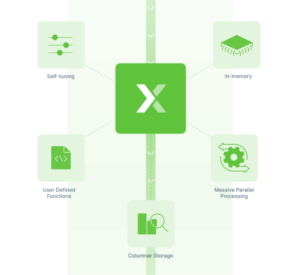
Exasol Eyes Second Half of 2023 for Two Big Developments

(Timofeev-Vladimir./Shutterstock)
In-memory analytics database developer Exasol has quietly made a name for itself among data warehouse users that need massive concurrency and sub-second response times for their SQL analytics operations. Now the German company is poised to ramp up its name recognition with two big announcements slated for the second half of 2023: a new release of the data warehouse that separates compute and storage, and potential profitability for the publicly traded company as a whole.
Exasol was founded in 2000 by Falko Mattasch as a way to commercialize a research project he was working on at the University of Jena to parallelize data processing. While the initial project wasn’t focused on analytics per se, Mattasch saw the potential for the algorithms he was involved in creating, and he subsequently founded Exasol to develop a data warehouse accelerator.
Oracle data warehouses were an early target for Exasol’s accelerator, which officially coming to market in 2008. Through the combination of a speedy in-memory layer as well as an on-disk cache of data, Exasol could reliably provide a speed and concurrency boost to production data warehouse that weren’t meeting requirements.
While Exasol didn’t market its product heavily, word began to spread in the analytics community, helped in part with a dedication to pursuing benchmark tests, particularly the TPC-H, to prove its price-performance claims. Over time, OLAP customers from Teradata, IBM, and Microsoft adopted the Exasol accelerator. The company doesn’t share customer figures, but it says it’s used by many Fortune 100 customers in financial services, teleco, retail, and healthcare.
“We specialize in our capability to do data loading and processing at a very large scale concurrency,” says Solongo Erdenkhuyag, who heads up customer success for Exasol from the company’s Washington, D.C. office. “We’re able to run through very complex queries on massive volumes of data with sub-second response. Concurrent OLAP is our bread and butter.”
Exasol doesn’t have the engineering resources of a Snowflake or an AWS, but it’s found a repeatable formula for success by helping customers get the most out of specific workloads, Erdenkhuyag says. It does this by developing sophisticated capabilities into its product, such as self-tuning, on-the-fly index creation, and smart data pre-fetching, she says.
“The market is fairly crowded. But when it comes to specific workloads and use cases, it’s much more nuanced,” Erdenkhuyag says. “If you’re looking for an in-memory database that can be deployed anywhere, and that gives you flexibility and time-to-data, there’s only one.”
There are three main deployment models for Exasol. First, it can plug into an existing OLAP setup as a speed layer. It can also function as the primary data warehouse, scaling out (or scaling up) to support hundreds of terabytes or even petabytes of data. Third, Exasol can be a consolidation layer for companies with multiple data warehouses.
The database can run on-prem or on any of the major public clouds. The company has a closer partnership with AWS, which named Exasol the partner of the year for Europe last year. In addition to utilizing Amazon S3 as object storage, Exasol is also well integrated into Amazon’s other big data offerings, such as Glue and Sagemaker.
“At the end of the day, a lot of big organizations or startups with a massive amount of data–they just want a reliable database,” Erdenkhuyag tells Datanami. “If you remove all the bells and whistles and everything that others may be trying to do, it’s really having fast concurrent OLAP, and being a powerful SQL engine.”
With that said, the company is looking to move forward and offer more capability. Support for object storage is particularly important for companies with massive data sets, which is why the company is embracing a cloud model.
“When you have large OLTP systems generating massive amounts of data, to try to do anything innovative , companies are looking elsewhere,” Erdenkhuyag says. “This is where the cloud story comes into play. So you need a much more composable systems architecture. You want the best of breed. I don’t think we’re going to move away from the centralized data lake and data warehouse story, although we are seeing trends in a more federated model. The beauty of Exasol is the flexibility. We support your deployment strategy and play very well in your existing ecosystem.”
In 2022, the company focused engineering efforts on delivering some of those bells and whistles. That includes the launch of a software-as-a-service (SaaS) delivery model on AWS one year ago. It also including more automation for upfront table design, which continues to be a mostly manual endeavor. The focus for 2023 is on delivering a major new release of the database that will feature the separation of compute and storage for the first time.
“We have the SaaS [offering]. We have the product that does data warehouse automation. And we have a newer version where we do separate compute and storage,” Erdenkhuyag says. “That’s a going to be really exciting for the customers who want to be able to spin down the computation part as needed.”
Separation of compute and storage will allow Exasol to operate as a first-class citizen in public cloud environments, as well as on-prem environments that have adopted cloud-native architectures. The new version, which the company is eyeing for release toward the end of the year, will also be instrumental in Exasol’s move toward a serverless offering, if it’s so inclined.
While the engineering team delivers improvements to the core database, Exasol executives have to be happy about how the company is doing financially. In November, the company unveiled results for the first nine months of the year, which was headlined by a 23% increase in annual recuring revenue (ARR) to €33.9 million, up from €27.5 million a year ago.
“…[O]ur profitability and liquidity have improved faster than originally expected, which is why we recently raised our outlook in this regard for the full year,” Jan-Dirk Henrich, CFO and Speaker of the Executive Board of Exasol, stated in a press release. “We are thus making rapid progress on our path to becoming profitable in the second half of 2023 and can finance our growth from our own resources as planned.”
Related Items:
Cloud Data Warehousing: Understanding Your Options
How Data Literate are the ‘D/Natives’?
EXASOL Shrugs Off Oracle’s In-Memory Speedup
































